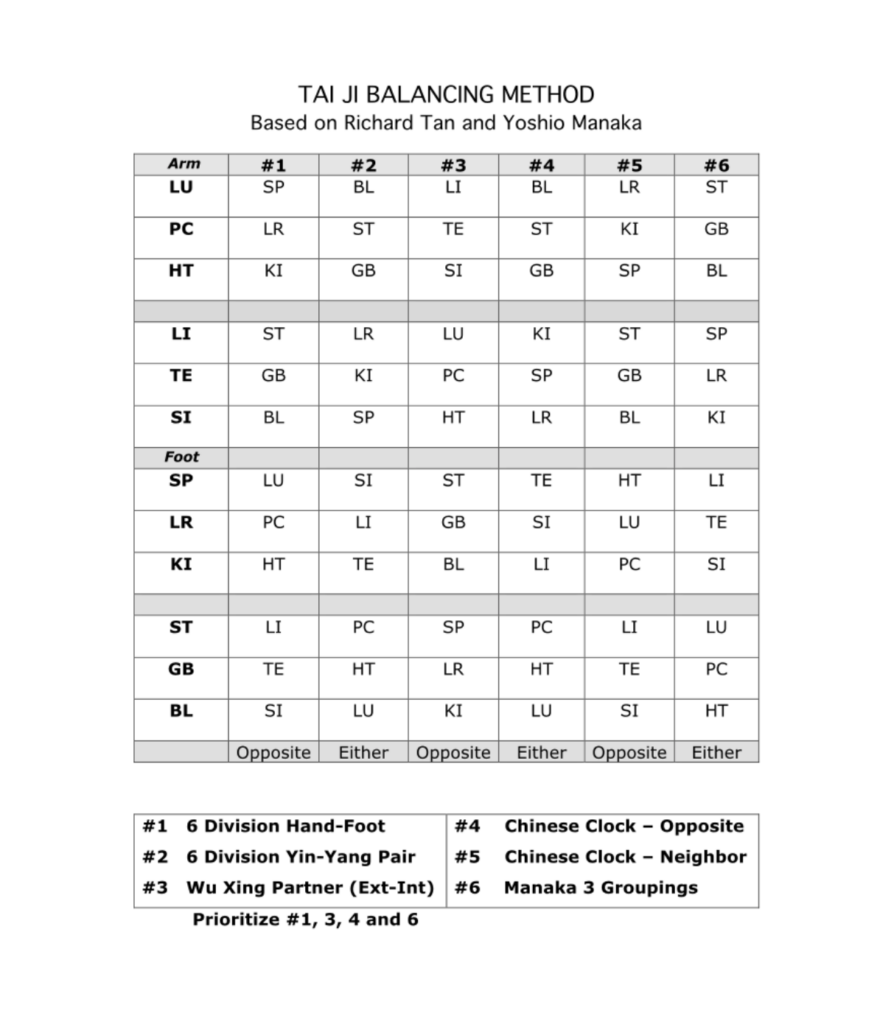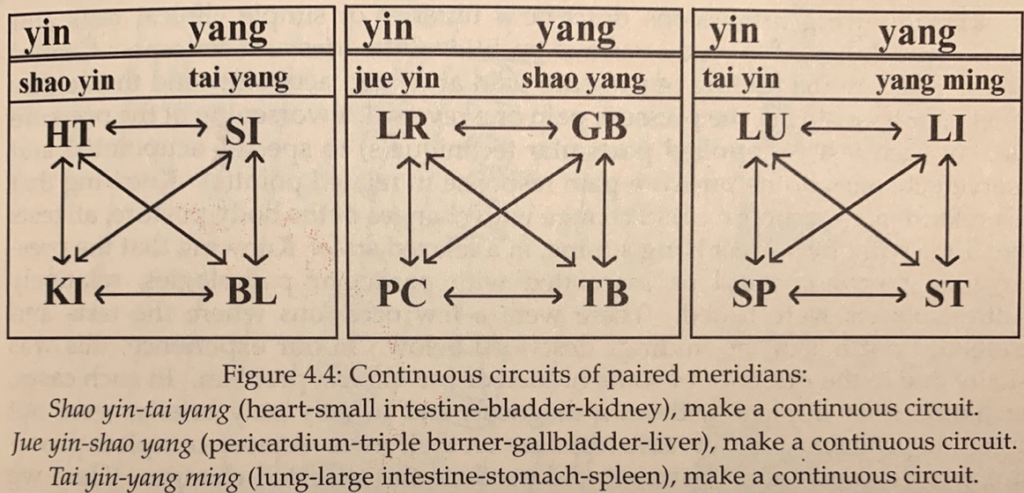
Other Posts in this Series
To read parts 1, 2 or 4 of The Primary Channel Balance series, click the links below:
- Part 1: The Primary Channel Balance
- Part 2: Modern Japanese and Chinese Approaches to Balancing Acupuncture Meridians
- Part 4: Treatment Examples
Part 3: The Taiji Balancing Method
This is Part 3 of The Primary Channel Balance by Dr. Jake Fratkin. Reading parts 1 and 2 will offer context. You can navigate to parts 1 and 2 in the “Other Posts in this Series” section above this paragraph.
When there are lots of channels out of balance, we really don’t want to be chasing every one (following Fukishima’s dictate.) So, what should we do? I have a clever solution: I use ion-pumping cords to connect the more extreme deficiencies with the more extreme excesses. In this case, we have guidance in the form of a chart called the Taiji Balancing Method (see below.) This chart lists classical relationships that can be used for this purpose. First organized by Dr. Richard Tan, from Taiwan and later California, the chart delineates five classical relationships. To this, we added a sixth, proposed by Yoshio Manaka.
To read the chart, the left column lists the channel you wish to balance, with six channels in columns to the right, based on different classical relationships. These relationships are used to balance a deficient channel with an excess channel. Your channel in the most left column can be either excess or deficient, as long as the channel chosen from the right-side columns is the opposite, eg, excess vs. deficient. We use ion-pumping cords to lead the excess channel (black lead) towards the deficient channel (red lead). You will have to decide which actual point to use, but common pairings are tonification to sedation or luo-connecting to yuan-source.

The Six Relationships
#1: Six Division Hand-Foot
These channels are placed geographically: medial, middle, lateral. Here, a hand channel is paired with a leg channel by the six-division organization: Taiyin (LU-SP), Jueyin (PC-LR), Shaoyin (HT-KI), Yangming (LI-ST), Shaoyang (TE-GB) and Taiyang (SI-BL). This relationship is commonly chosen.
#2: Six Division Yin-Yang Pair
This is a more obscure relationship, based on the couplings of the six divisions according to yin and yang. The sequence can be visualized on the Yin/Yang menu, left side of the AcuGraph page. LU-BL (Taiyin-Taiyang), SI-SP (Taiyang-Taiyin), HT-GB (Shaoyin-Shaoyang), TE-KI (Shaoyang-Shaoyin), PC-ST (Jueyin-Yangming), LI-LR (Yangming-Jueyin). Incidentally, this is the meridian coupling preferred in Master T’ung’s acupuncture system, as detailed by Dr. Wei-Chieh Young in “Lectures in Tung’s Acupuncture”. They applied contralateral needling.
#3: Wu Xing (Five Element) Partner; External-Internal
This couples the yin and yang partners of each element. LU-LI (Metal), PC-TE (Ministerial Fire), HT-SI (Fire), SP-ST (Earth), LR-GB (Wood), KI-BL (Water). These pairings can be visualized using the Five Element menu on the AcuGraph page.
#4: Chinese Clock – Opposite
For reference, use the Horary menu of the AcuGraph page. This balances two channels by crossing over to the relevant channel on the other side of the day. LU-BL, PC-ST, HT-GB, LI-KI, TE-SP, SI-LR. These can be directed in either direction. My teacher Dr. Ineon Moon liked using this combination, if he knew that both partners were in obvious excess-deficiency.
#5: Chinese Clock – Neighbor
These channels are adjacent to each other in the bioclock sequence, and work well in blockages. LU-LR, KI-PC, SP-HT, LI-ST, TE-GB, SI-BL.
#6: Manaka 3 Groupings
Yoshio Manaka saw three fundamental pairings of yin and yang channels, which he felt represented continuous circuits of paired meridians. Each group has four channels, two pairs. Two of the points connect as the Wu Xing/Five Element pair (#3). The other pair is determined by a cross-over link, represented in this graph and listed as #6:

The image about is from Chasing the Dragon’s Tail, Yoshio Manaka, Paradigm Publications, 1995, 2014, p. 59
Summary
In summary, the idea is to use one of the six groupings on the Taiji Balancing Method chart (above) to pair a more extreme channel excess with a more extreme channel deficiency, using ion-pumping cords. In practice, #1, 3 and 6 are used most often, although I like and use any of the pairings. I think they all work! The pairings should connect an obvious excess channel with an obvious deficient channel (black lead on the excess, red lead on the deficient). But the partner chosen should be included on the Taiji Balancing Method chart. By using ion-pumping cords, the balance is made most efficiently.
This means looking at all the possibilities. For example, if KI is weak/deficient, look at the chart to see if any of the six possibilities are particularly excess, and use that one. You don’t want to connect to a green (normal), and you don’t want to connect an excess to an excess, or a deficient to a deficient.
In Part 4 of this series, we’ll look at some actual treatment examples to apply these concepts.
Other Posts in this Series
To read parts 1, 2 or 4 of The Primary Channel Balance series, click the links below:
- Part 1: The Primary Channel Balance
- Part 2: Modern Japanese and Chinese Approaches to Balancing Acupuncture Meridians
- Part 4: Treatment Examples

Save $300 on AcuGraph through Thursday, July 22, 2021!
AcuGraph is an invaluable tool when it comes to balancing the acupuncture channels. It’s the tool recommended and endorsed by Dr. Fratkin, and is integral to his methods and success.
To help you implement everything you’re leaning in Dr. Fratkin’s blog series, you can get $300 off the AcuGraph Practice Builder package through July 22, 2021!
Click Here to Learn more about AcuGraph >>
Save $300 on the AcuGraph Practice Builder Package >>

Jake Paul Fratkin, OMD, L.Ac. trained in Korean and Japanese acupuncture since 1975, and Chinese herbal medicine since 1982. He is the author of Essential Chinese Formulas (2014), and Chinese Herbal Patent Medicines, The Clinical Desk Reference (2001). Jake practices in Boulder, Colorado, where he specializes in internal disorders, infections, and pediatrics.
2 Replies to “The Primary Channel Balance – Part 3”